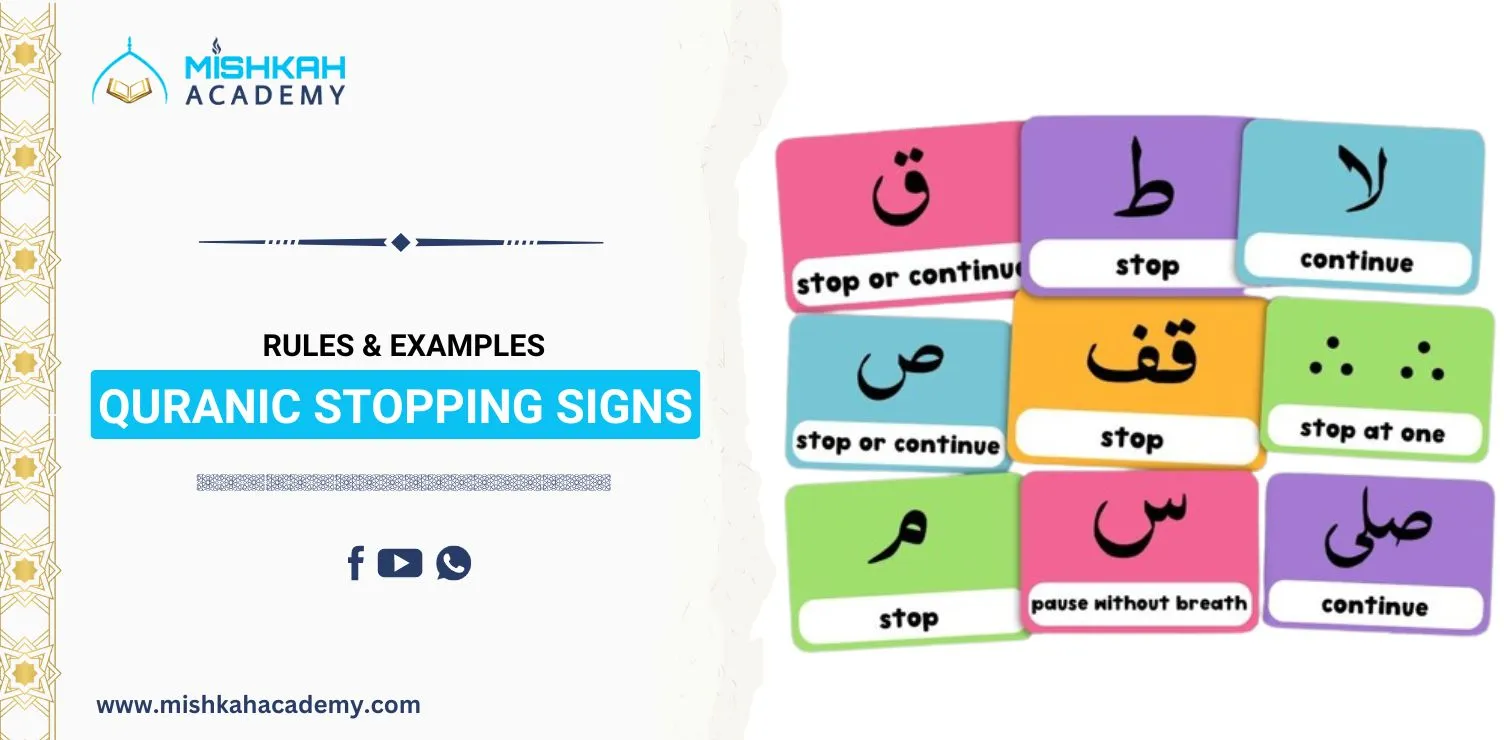The Quran is the final word of revelation from Allah, so it’s important to read it clearly and with proper pronunciation. Following the waqf symbols, or stopping signals, indicates when a reciter should pause, continue, or stop when reciting the Quran correctly. These quran reading rules indicators, sometimes referred to as tajweed symbols, aid in maintaining the text’s meaning and preventing misunderstandings. To help with accurate and simpler Quran recitation, we shall examine the meanings of these stopping symbols along with several examples.
Knowing the Quran’s Stopping Signs (Waqf)
Table of Contents
ToggleIn Arabic, waqf means “to pause” or “to stop.” Waqf symbols help the reader stop at the right place while reciting the Quran without changing the meaning of the verses. The guidelines for halting are derived from traditional Islamic research on Tajweed, the term for the collection of guidelines dictating how the language of the Quran should be pronounced. It’s crucial to know how to utilize these symbols correctly because misusing them could change their meaning.
Quranic Stopping Signs
⃝ – Waqf e Taam
مـ – Waqf e Lazim
ط – Waqf e Mutlaq
ج – Waqf e Jaaiz
ز – Waqf e Mujawwaz
ص – Murakh-Khas Waqf
صلي – Al-Wasl Awlaa
قف – Qif
س – Saktah
وقفتہ – Waqfah
لا – Laa
ك – Kadhaalik
∴ – Mu’anaqah
Note: Enroll in Mishkah Academy online tajweed course to learn to read quran by knowing quran stopping rules and signs properly.
Important Quranic Symbols that stop
The Quran is filled with several waqf signs, which are positioned at certain passages to advise the reciter whether to halt, pause, or proceed. Here are the most popular symbols, along with their definitions and instances.
1. مـ (Mīm) – Waqf Lazim (Mandatory Stop):
This symbol denotes the necessity of stopping. The meaning of the verse may be significantly changed if the reciter keeps going without pausing.
Rule: Resuming recitation from the next word, stop at this sign.
Example:
Surah Al-Kahf, 18:1 – ٱلۡحَمۡدُ لِلَّهِ ٱلَّذِيٓ أَنزَلَ عَلَىٰ عَبۡدِهِ ٱلۡكِتَـٰبَ وَلَمۡ يَجۡعَل لَّهُۥ عِوَجَا (م)
In this example, you must stop at the sign (م).
In this case, you have to stop at the ΅ sign.
2. ط(Ṭāʾ) – Waqf Mutlaq (Permissible Stop)
This sign indicates that, while halting is not required, it is strongly advised to prevent changing the meaning.
Rule: It’s okay to stop, but you can also go on if necessary.
Example:
Surah An-Nisa, 4:35 – وَٱللَّهُ سَمِيعٌۢ بَصِيرٌۭ (ط)
It is best to end it here, although carrying on won’t distort the meaning in any way.
3. ق (Qāf) – Waqf Qila (Optional Stop)
Definition: An optional stop is indicated by this symbol. While stopping is OK, it is best to keep going in order to preserve the meaning’s flow.
Rule: Although it’s preferable to continue, you can stop if needed.
Example:
Surah Al-Mu’minun, 23:1 – قَدۡ أَفۡلَحَ ٱلۡمُؤۡمِنُونَ (ق)
Although you are free to stop here, it is usually preferable to go on.
4. لا (Lā) – Waqf Mamnuʿ (No Stop Allowed) –
Definition: It is forbidden to stop using this symbol. The integrity of the passage requires us to keep going without stopping.
The rule is to never stop at this sign.
Example:
Surah Al-Baqarah, 2:2 – ذَٰلِكَ ٱلۡكِتَـٰبُ لَا رَيۡبَۛ (لا) فِيهِ
It is not permitted for you to halt at “لُا” (Lā).
5. ج (Jīm) – Waqf Ja’iz (Permissible Stop)
This sign is signaling that stopping is allowed. It is perfectly okay to stop or to continue; neither will change the meaning.
Rule: You may quit or continue, whichever seems most comfortable.
Example:
Surah Al-Baqarah, 2:25 – تَجۡرِي مِن تَحۡتِهَا ٱلۡأَنۡهَـٰرُۖ (ج
You don’t have to finish to understand the meaning.
6. س (Sīn) – Waqf Saktah (Short Pause) – س (Sīn)
Definition: This symbol denotes a quick stop without inhaling. It is used to break apart two sentences without using a full stop.
Rule: Recite the passage for a short while without breathing in.
Example:
Surah Al-Qiyamah, 75:27-28 – وَقِيلَ مَنۡۜ رَاقٍۢ (س) وَظَنَّ أَنَّهُ ٱلۡفِرَاقُ (س)
You should pause briefly at “رَاقٍۢ” without taking a breath.
7. ٱ (Ayah’s End) – Waqf Ayah (Verse’s End)
Definition: The end of a verse (ayah) is indicated by this sign. It’s usually advised to pause here, take a breath, and then carry on.
Rule: Don’t continue until doing so clarifies the meaning.
Example:
Surah Al-Fatiha, 1:5 – إِيَّاكَ نَعۡبُدُ وَإِيَّاكَ نَسۡتَعِينُ (ٱ)
This is the end of the verse, therefore you should stop here.
Stopping Rules in the Quran with Examples
There are eighteen rules in total. Anyone can read the Quran in the most proper manner by understanding these guidelines.
| Name/Sign | What It Is | Example |
| – Waqf e Taam | A regular pause where you stop briefly. | قَالَ ٱلَّذِى جَعَلَ لَكُمُ ٱلۡأَرۡضَ قَرَٲرٗا وَٱسِلَـٰهَۤا” (He who made the earth for you as a bed.) |
| مـ – Waqf e Lazim | A mandatory stop; you must pause to avoid altering meaning. | “وَٱللَّهُ خَذُولُ غَفُورٌ۬” (And Allah is Forgiving, Merciful.) |
| ط – Waqf e Mutlaq | A complete, unrestricted pause. | “ٱعۡبُدُواْ رَبَّ هَـٰذَا ٱلۡبَيۡتِ” (Worship the Lord of this House.) |
| ج – Waqf e Jaaiz | A permissible pause, but not mandatory. | “قُلۡ مَا كُنتُ بِدۡعٗا مِّنَ ٱلرُّسُلِ” (Say, I am not a new messenger.) |
| ز – Waqf e Mujawwaz | A pause that’s more extended but permissible. | “فَفَهَّمۡنَـٰهَا سُلَيۡمَـٰنَ” (So We gave Solomon understanding of it.) |
| ص – Waqf e Murakh-Khas | A specific pause for emphasis. | “وَلَوۡ نَشَآءُ لَبَعَثۡنَا فِى كُلِّ قَرۡيَةٍ۬ نَّذِيرٗا” (Had We willed, We could have sent a warner.) |
| صلي – Al-Wasl Awlaa | Stopping is allowed, but it’s preferable to continue. | ٱلسَّمَآءِ وَٱلطَّارِقِ” (By the sky and the morning star.) |
| ق – Qeela ‘Alayhil-Waqf | A pause is indicated, but not mandatory. | فَمَاذَا بَعۡدَ ٱلۡكُفۡرِ” (So what is there after disbelief?) |
| صل – Qad Yusal | Stopping with a pause, often brief. | أَفَلَا تَنظُرُونَ” (Will you not then see?) |
| قف – Qif | A full stop where you must pause. | “كَفَرَتۡ قَبۡلُہُمۡ قَوۡمُ نُوحٖ” (Before them the people of Noah denied.) |
| س – Saktah | A light pause without taking a breath, similar to “ج”. | “فَكَيۡفَ كَانَ عَذَابِى وَنُذُرِ” (So how was My punishment and warning?) |
| وقفتہ – Waqfah | A longer pause, often at the end of a verse. | “فَلَنُقۡصِرُنَّهُ عَلَىٰ نَفۡسِهِۦۖ” (We will shorten him upon himself.) |
| لا – Laa | No stop is allowed; continue reciting. | “لَا تُدۡرِكُهُ ٱلۡأَبۡصَـٰرُ” (Vision perceives Him not.) |
| ك – Kadhaalik | Another way to pause without stopping completely. | “كَذَّبَتۡ عَادٞۖ” (The people of Aad denied the truth.) |
| ∴ – Mu’anaqah | A momentary pause or hesitation | “وَلَا نَقُولُ إِلَّا ٱخۡتَلَفَتۡ رُءُوسُنَا” (We do not say anything except our minds have differed.) |
| قف النبی – Waqf-un-Nabi | Pause where Prophet Muhammad (PBUH) stopped. | وَٱللَّهُ عَلِىمٌ حَكِيمٞۖ” (And Allah is All-Knowing, All-Wise.) |
| قف غفران – Waqf e Ghufraan | A pause when seeking forgiveness. | وَإِن تُطِعۡ أَڪۡثَرَ مَن فِى ٱلۡأَرۡضِ” (If you obey most of those on earth, they will lead you astray.) |
| قف منزل – Waqf e Manzil | A pause at significant points in the Quran. | “قَدۡ كَذَّبَتۡ قَبۡلَهُمۡ قَوۡمُ نُوحٖ” (The people of Noah denied before them.) |
Importance of Stopping Signs in Quran
Meaning Clarity: By pausing at the appropriate point, the reciter can ensure that the relevant message is conveyed and the verse’s meaning is made clear.
Correct Tajweed: In order to maintain the integrity of the Quran, the science of Tajweed places equal emphasis on pronunciation as well as appropriate halting and stopping locations.
Ease of Recitation: The waqf signs simplify and ease the recitation, especially for novices, by breaking lengthy verses into smaller, more digestible chunks.
Conclusion
It is important to understand and use these stop signals in order to recite the Quran correctly. By adhering to these symbols, one can make sure that Allah’s words are understood and that their meaning is maintained. Each of these indicators—whether the pause is required, free and open, or discouraged—is important to mastering your Tajweed recitation.
Every Muslim desires to learn the Holy Quran. But if you are reading the Holy Quran but you are ignorant of the main rules of Quran recitation, then there is no need for that. With Mishkah Academy, you can now enroll in our online quran recitation course and start learning 12 tajweed rules, including the rules for stopping when reciting the Quran.






